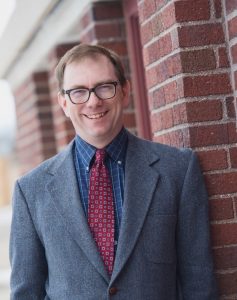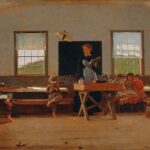This essay is part of a mini symposium on the opportunities and challenges educators face in the wake of a year-and-a-half of COVID. You can view all the contributions here.
Aberdeen, SD. Here is a phenomenon I’ve recently experienced. As students begin to assemble at my university in anticipation of the commencement of a new term, I’ve had students wave to me and say, “Hey Prof. Schaff!” I glance over at who is hailing me and encounter that awkward moment we have when someone is calling us by name but we have no idea who that person is. That anxious searching of memory begins: “I obviously had this student in class. What the heck is his name? Think, brain, think!” I engage in some jocular banter, all the time praying that my ignorance of the other person’s name will not be exposed.
We all have similar moments from time to time, but why are so many students talking to me with such familiarity while I struggle to place them? I’m not that old. Then it occurred to me. Masks. Zoom. I taught all last year looking at a room full of masked students or speaking to disembodied students through a camera. I really didn’t know what these students looked like. Today, as South Dakota is remarkably free of COVID anxiety (for good or ill), I am encountering students, some of whom I had in multiple classes, whose faces I have never seen. They are almost completely new people.
This, to me, is one of the cruel manifestations of what I suppose we can call the Era of COVID. Last year my institution, like almost all educational institutions, put multiple policies in place to deal with the pandemic. We were among the lucky ones. We actually had school in person all year. To be fair, none of us thought it could be done. At our first department meeting in Fall 2020, I was the optimistic one thinking that we had a 50/50 shot of making it through the semester without going online. As South Dakota’s numbers spiked last November we wondered if we’d come back face-to-face for the ironically named Spring Term that begins in January. We did. We made it, but even our relatively “normal” year of education took place under restrictions.
First, as noted, everyone was required to wear a mask indoors. Faculty were allowed to be maskless in our offices, but not if someone showed up. Also, faculty were allowed to teach in any “face covering.” Most of us went with a plastic face shield as they allow you to project better than with a mask, and they allow students to see your lips, thus more easily understanding what you are saying.
Second, our classroom capacity was reduced for social distancing. All desks or chairs were at least six feet apart, with tape on the floor demarcating the limited boundaries of each piece of furniture. My general education American Government was big enough that I had to move to an auditorium to teach the course in compliance with social distancing. Imagine about thirty-five students spread out amongst three-hundred or so chairs. I have a well-developed “teacher’s voice” so I typically have no problem being heard in class, but here I had to turn on a microphone to amplify my voice through a sound system.
We were also encouraged to offer our classes “Hyflex.” In practice what this meant is that all of my classes were offered on Zoom. Particularly in the Fall, a student could encounter the class one of three ways. They could actually show up to class while masking. Next, they could tune in live via Zoom. Finally, each class was recorded, so a student could watch the class at some later time. This added another layer of preparation as each class was proceeded with various pieces of technology being engaged to record the class. By year’s end we were pros.
You add up all these pandemic-related measures—masks, students spread out, student attending class virtually—and what you get is a deeply impersonal education, which isn’t much of an education at all. Our Fall 2020 term was a learning experience. Most of my colleagues and I noticed as the term went on fewer and fewer students attended class. They were on Zoom, either live or (maybe) later. Remember those thirty-five American Government students socially distanced in the auditorium? By then end of the term only about ten or eleven would show up on a given day, the rest attending class (or not) via Zoom. Colleagues informed me of coming to class only to realize no one was in the room. Everyone was on Zoom. They taught to faceless students on a computer. Other colleagues noted that they’d call on students attending via Zoom only to get no response. The student had logged in and then went away, making it appear as if he or she was there. So we had students “attend” our classes for a whole semester, and we had almost no idea who they were or what they looked like.
We got wise, and in the Spring 2021 term the university adjusted the guidelines to give students less leeway. Things got better regarding attendance in person. Still, all students remained masked each day.
As Jeff Bilbro noted relatively early in the pandemic, when the curse first hit there was at least the blessing that we had formed some kind of personal relationship with students before going virtual in Spring 2020. Again, while I was lucky that I got to teach face-to-face (sort of) the following Fall, there was a wall between my students and me. We were physically separate even when in the same room. Many were simply names on a Zoom call. Those in class were behind a mask. Face-to-face was thus mostly a misnomer. I teach a good number of freshman. I am sad to say I hardly got to know them, thus my problems with knowing those returning students’ names. After the fact I realized that one student whom I chatted with recently had been in my First Year Seminar the previous Fall. His name is Dylan. I won’t forget again. My mistake was caused by the fact that although Dylan and I had spent roughly thirty hours in each other’s company a year ago, I’d never seen his face. Another student who had taken two three-credit classes from me, thus adding up to about ninety hours together, was almost completely unknown to me.
We long for physical connection with each other. My students want me to recognize them and know their names. It amazes me how much of a barrier a cheap piece of cloth over a student’s face altered our relationship. At a certain point I simply despaired of learning freshman names, as I could literally not match a name to a face. I’d have students slip off a mask during class to take a drink and I’d think, “Wow! That is nothing like what I thought that person looked like.” They were to that extent strangers to me.
We are indeed embodied souls. If the face is the key to one’s persona, then to cover that face is to hide a little of who one is. While Zoom and like technologies might be (barely) adequate substitutes for those who already have embodied relationships, they will not suffice to inaugurate a new relationship or to revive an old one. How can we be in communion with each other while hiding our faces or perhaps our whole bodies from each other? If the point of college, as the very term “college” implies, is to come together for the enterprise of learning, that coming together has to be more than a name or face on a screen, or a pair of eyes peeking out behind the mask. Especially for those of us at smaller schools, where one of our advantages is the ability to form personal relationships, that advantage is lost if we obscure the person behind a screen or mask.
The distance created by technology has another detriment. By now almost all of us have been in virtual meetings. Therefore almost all of us know the temptation to multitask during said meetings. As I and a co-author have discussed elsewhere, the distraction that is almost endemic to the online world makes virtual learning invariably inferior to in-person learning. We all know the temptation to check email, browse the web, look up some fact someone has just brought up. Anything but giving attention. Attention comes from the ability to look each other in the eye. It is the kinetics of a teacher moving about the room, writing things on the board. The capability of reading the room so as to decipher if you should slow down, speed up, go over that again, tell a bad joke to wake people up. I know devotees of online learning who maintain that these can be reproduced online. I am skeptical that this is so, or, if it can be done, it takes enormous effort to replicate that which comes naturally in the classroom.
I should note that I am not claiming that these anti-COVID restrictions were unwise. Given the state of knowledge at the time and the lack of a vaccine, masking, distancing, and providing at least some accommodation to students was a defensible policy. The argument over the prudence of pandemic-related restrictions is an argument for another essay. But we can assess the inevitable costs of these pandemic policies and perhaps gain some perspective on what makes education worthwhile.
When the pandemic first started, and my institution went virtual, I asked my students how they were doing. A student emailed and expressed her frustration. She was a freshman and a student-athlete to boot. She was angry. She had been waiting for years for her college adventure. She wanted to leave home, have new experiences, meet new people, and compete in her sport at a higher level. Now here she was, back home, living with her parents, learning on a computer, with her sport’s season cancelled due to the pandemic. I suspect her frustration was shared, in one way or another, by many students across the nation.
In this may lie an opportunity. Students perhaps realized what they were missing. Learning is not simply a transfer of information, something that online technology enables us to do fairly well. Learning is relationship. We need to be with each other, see each other, and share with each other. My school is, for now, “business as usual.” We have made very few concessions to the pandemic. As I write this we have completed exactly two days of class. It is a joy to see my students’ faces. And perhaps, together, we can commence learning from one another.





1 comment
Brian
“She was angry. She had been waiting for years for her college adventure. She wanted to leave home…”
So sad that this is what our society does–encourage people to leave their homes, destroying so many neighborhoods, towns, cities, and obliterating multi-generational “sense of place”-ness, rootedness, etc. And has it resulted in increased happiness overall? I dare anyone to say it has.
Comments are closed.